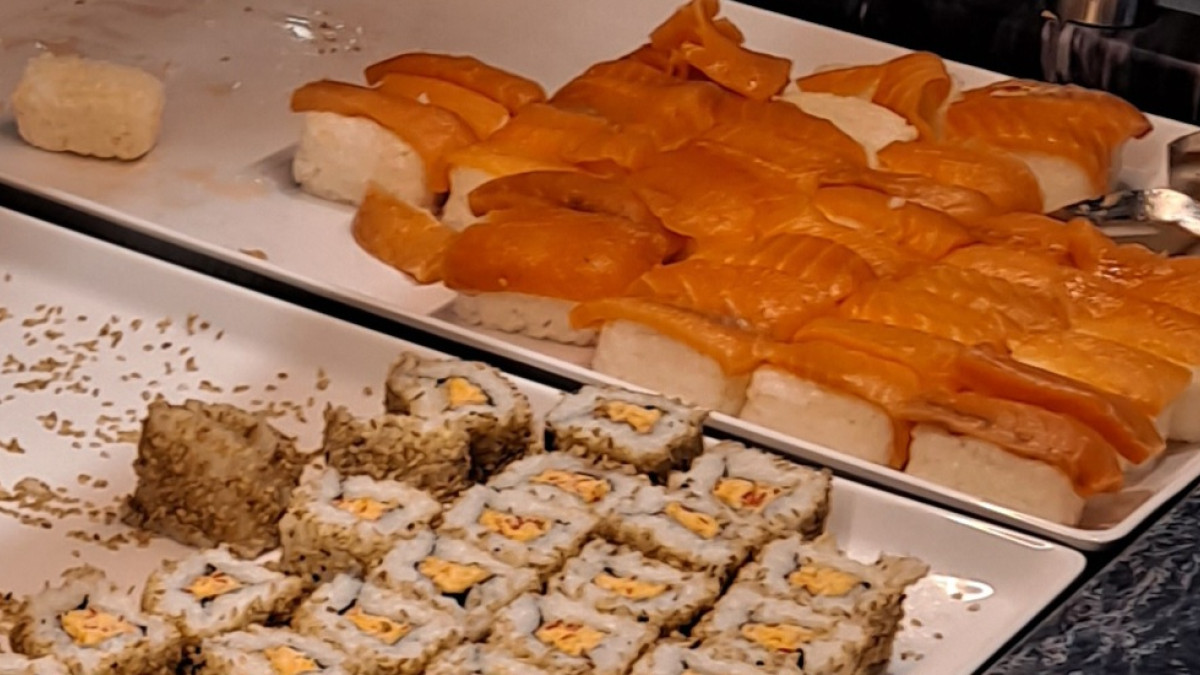
- Environmental protection
- Health surveillance
- Animals
- Decision
- Online transaction
- Contact us

In the summer of 2023, the environmental activities of the Lappeenranta and Imatra regions investigated the microbiological quality of sushi offered by restaurants and stores in the area. The results of the sampling project, which is part of the systematic monitoring of the Lappeenranta and Imatra region, showed the microbiological quality to be quite good.
The results are only indicative, as the examined material is quite small. The samples were taken from five store preparation points, six restaurants and two consumer-packaged sushi assortments delivered to the store.
Lappeenranta region environmental health inspector Anne-Mari Kauppinen in Lappeenranta, salmon nigiri and consumer-packaged sushi variety boxes were selected as samples, and in Imatra, one piece of three different types of sushi was taken as a sample from the buffet of each restaurant under investigation.
- A total of 23 samples were examined in the project, two of which were repeat samples. In terms of microbiological quality, there were ten (43%) good samples, nine (39%) avoidable and four (17%) bad samples.
Environmental engineer of the environmental department of the Imatra region Ilkka Kosonen says that in terms of laboratory studies, aerobic microorganisms, i.e. total bacteria, were the tested factors that decreased the microbiological quality of the samples the most.
- A high total bacteria count is generally influenced by the quality and freshness of the raw materials, the storage time of the products, and the handling hygiene.
- The freshness and storage of the fish used in the preparation can especially affect sushi. The quality of the fish in the preparation of sushi is best preserved when fresh frozen fish is used. The fish should be thawed in a refrigerator.
Bacillus cereus, coagulase-positive staphylococci, listeria and salmonella were studied among the bacteria that cause food poisoning. Bacillus cereus was present in avoidable amounts in two samples.
- The abundant presence of Bacillus cereus is often associated with insufficient cooling. Sushi rice is processed at room temperature, which allows Bacillus cereus to grow. On the other hand, the vinegar used to flavor sushi rice inhibits the growth of Bacillus cereus. The pH of one sample exceeded the recommended value, says Kosonen.
Coagulase-positive staphylococci were detected in three samples in an avoidable amount. Staphylococci can be an indication of unhygienic working practices.
- Salmonella, on the other hand, was examined in samples containing shellfish. Salmonella was not detected in any of the samples. Listeria monocytogenes was found in one sample, however, in further tests the concentration was below the detection limit, Kauppinen states.
Working hygiene and the quality of raw materials are important in sushi production
In connection with the sampling, items such as sushi sales times, serving and selling temperatures, and rice preparation and cooling were examined. According to Kauppinen, deficiencies were found in the temperature control of the sushi, the cleanliness of the surfaces, and the cooling and freshness of the raw materials.
- In the temperature monitoring of stores and restaurants, only the temperature indicated by the meter of the refrigerator was often monitored. In one store, it was discovered that consumer-packaged sushi assortments had arrived at the store unrefrigerated. There were also often deficiencies in monitoring the pH of sushi.
Suspected food poisoning related to sushi has been very rare in Finland, but sushi is a potential cause of food poisoning due to the raw fish it contains and the manual preparation. When making sushi, good working hygiene and good quality of raw materials are important.
- Based on the results, operators were given written instructions and asked to take into account the sample results as necessary in self-monitoring. If necessary, the supervision also addressed detected deficiencies and ensured that the operation was corrected, says Kosonen.
The results and observations of the sampling project concerning the microbiological quality of sushi are taken into account in the Oiva inspections of the investigated sites.
Environmental action of the Lappeenranta region:
Anne-Mari Kauppinen, health inspector
tel. 040 759 6594, anne-mari. merchant lappeenranta.fi (anne-mari[dot]kauppinen[at]lappeenranta[dot]fi)
lappeenranta.fi (anne-mari[dot]kauppinen[at]lappeenranta[dot]fi)
Virpi Laamanen, veterinary hygienist
tel. 040 762 0510, virpi. lamanen lappeenranta.fi (virpi[dot]laamanen[at]lappeenranta[dot]fi)
lappeenranta.fi (virpi[dot]laamanen[at]lappeenranta[dot]fi)
Environmental action of the Imatra region:
Ilkka Kosonen, environmental engineer
tel. 020 617 4631, ilkka.kosonen imatra.fi (ilkka[dot]kosonen[at]imatra[dot]fi)
imatra.fi (ilkka[dot]kosonen[at]imatra[dot]fi)